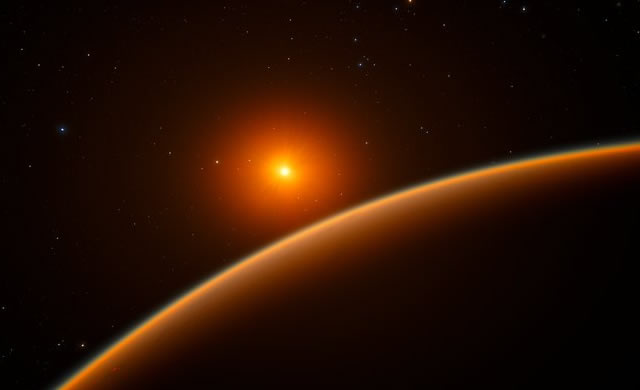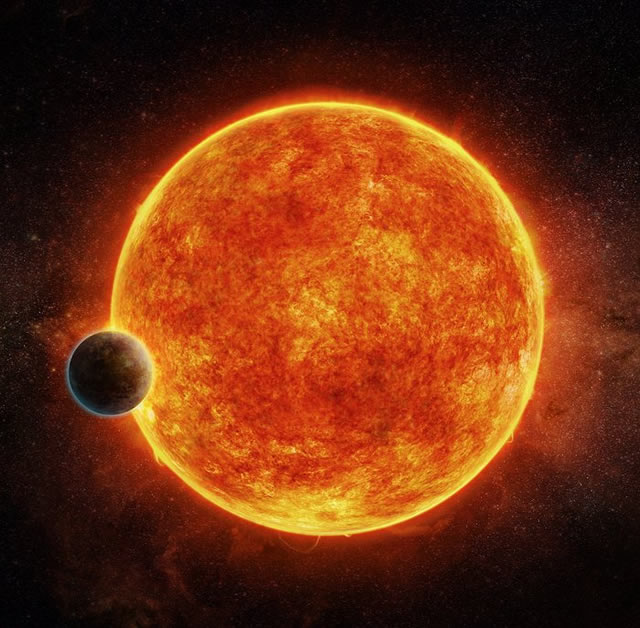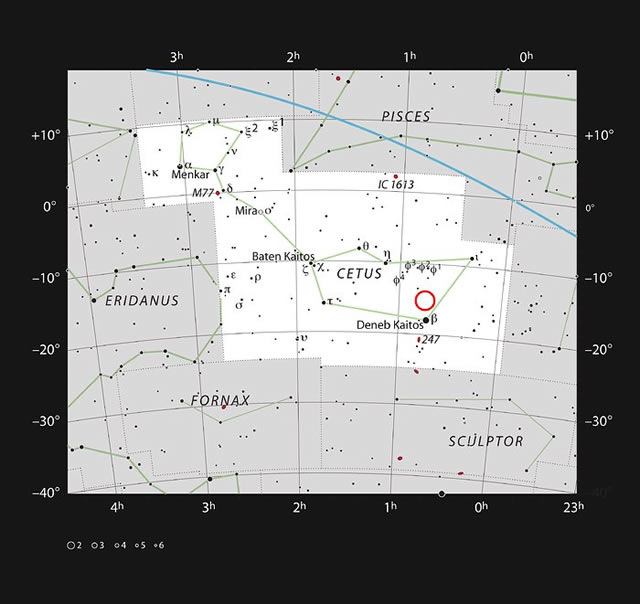
LHS 1140b – Credit: ESO/spaceengine.org
Una super-Terra rocciosa nella zona abitabile transita di fronte a una tranquilla nana rossa – Un esopianeta in orbita intorno a una nana rossa a circa 40 anni luce dalla Terra potrebbe essere il nuovo detentore del titolo “miglior luogo in cui cercare segni di vita al di là del Sistema Solare”. Con lo strumento HARPS dell’ESO a La Silla e altri telescopi in tutto il mondo, un’equipe internazionale di astronomi ha scoperto una “super-Terra” in orbita nella zona abitabile che circonda la debole stella LHS 1140. Questo mondo è poco più grande e molto più massiccio della Terra e probabilmente ha mantenuto la maggior parte della sua atmosfera. Questo, insieme al fatto che il pianeta passa di fronte alla propria stella durante l’orbita, lo rende uno degli obiettivi più interessanti per gli studi delle atmosfere planetarie. I risultati del lavoro verranno pubblicati sul numero del 20 aprile 2017 della rivista Nature.
La super-Terra LHS 1140b appena scoperta orbita nella zona abitabile che circonda una debole nana rossa, LHS 1140, nella costellazione della Balena. Le nane rosse sono molto più piccole e più fredde del Sole e, anche se LHS1140 è dieci volte più vicino alla propria stella di quanto non sia la Terra al Sole, riceve solo metà della luce rispetto alla Terra e si trova al centro della zona abitabile. Dalla Terra, vediamo l’orbita quasi perfettamente di taglio e vediamo, una volta ogni orbita cioè ogni 25 giorni, che l’esopianeta, quando passa di fronte alla propria stella, ne blocca in piccola parte la luce. “È il pianeta extrasolare più esaltante che io abbia mai visto nell’ultimo decennio!” afferma l’autore principale della ricerca Jason Dittmann dell’Harvard-Smithsonian Center for Astrophysics (Cambridge, USA). “È difficile sperare in un migior candidato per una delle indagini più appassionanti nella scienza – la ricerca di prove dell’esistenza di vita oltre la Terra.” “Le condizioni attuali della nana rossa sono particolarmente favorevoli – LHS 1140 ruota più lentamente e emette meno radiazione ad alta energia di altre stelle simili di piccola massa.” spiega un altro membro dell’equipe, Nicola Astudillo-Defru dell’Osservatorio di Ginevra, Svizzera. Perchè la vita come la conosciamo possa sostenersi, un pianeta deve avere acqua superficiale allo stato liquido e possedere un’atmosfera stabile. Le stelle di tipo nana rossa, quando sono giovani, emettono radiazioni che possono danneggiare l’atmosfera dei pianeti che le orbitano. In questo caso, la grande dimensione del pianeta implica che un oceano di magma avrebbe potuto esistere sulla superficie per milioni di anni. Questo ribollente oceano di lava avrebbe emesso vapore acqueo nell’atmosfera per un tempo molto lungo dopo che la stella si fosse calmata fino a raggiungere la sua emissione energetica attuale, costante, continuando così a rifornire il pianeta di acqua.
Fonte/Leggi tutto → ESO.org

LHS 1140b – Credit: M. Weiss/CfA
Newly Discovered Exoplanet May be Best Candidate in Search for Signs of Life – Transiting rocky super-Earth found in habitable zone of quiet red dwarf star – An exoplanet orbiting a red dwarf star 40 light-years from Earth may be the new holder of the title “best place to look for signs of life beyond the Solar System”. Using ESO’s HARPS instrument at La Silla, and other telescopes around the world, an international team of astronomers discovered a “super-Earth” orbiting in the habitable zone around the faint star LHS 1140. This world is a little larger and much more massive than the Earth and has likely retained most of its atmosphere. This, along with the fact that it passes in front of its parent star as it orbits, makes it one of the most exciting future targets for atmospheric studies. The results will appear in the 20 April 2017 issue of the journal Nature.
The newly discovered super-Earth LHS 1140b orbits in the habitable zone around a faint red dwarf star, named LHS 1140, in the constellation of Cetus (The Sea Monster). Red dwarfs are much smaller and cooler than the Sun and, although LHS 1140b is ten times closer to its star than the Earth is to the Sun, it only receives about half as much sunlight from its star as the Earth and lies in the middle of the habitable zone. The orbit is seen almost edge-on from Earth and as the exoplanet passes in front of the star once per orbit it blocks a little of its light every 25 days. “This is the most exciting exoplanet I’ve seen in the past decade,” said lead author Jason Dittmann of the Harvard-Smithsonian Center for Astrophysics (Cambridge, USA). “We could hardly hope for a better target to perform one of the biggest quests in science — searching for evidence of life beyond Earth.” “The present conditions of the red dwarf are particularly favourable — LHS 1140 spins more slowly and emits less high-energy radiation than other similar low-mass stars,” explains team member Nicola Astudillo-Defru from Geneva Observatory, Switzerland. For life as we know it to exist, a planet must have liquid surface water and retain an atmosphere. When red dwarf stars are young, they are known to emit radiation that can be damaging for the atmospheres of the planets that orbit them. In this case, the planet’s large size means that a magma ocean could have existed on its surface for millions of years. This seething ocean of lava could feed steam into the atmosphere long after the star has calmed to its current, steady glow, replenishing the planet with water.

Location of the faint red star LHS 1140 in the constellation of Cetus
Credit: ESO/IAU and Sky & Telescope





















